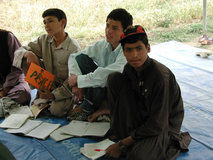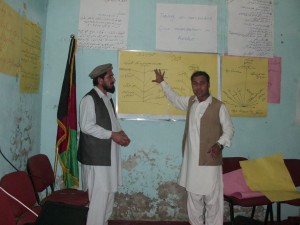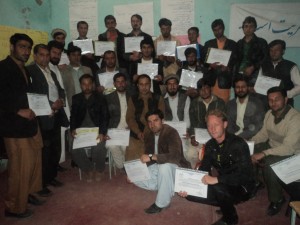 Those who know the Reach And Teach story know that a significant reason we do what we do today is because of the experience we had in Afghanistan in 2002. Having witnessed the horrible destruction from 30 years of civil war coupled with the massive bombing campaign waged by the US and its allies after the September 11th attacks, we knew that the people we met were weary of violence being the only solution to their problems.
Those who know the Reach And Teach story know that a significant reason we do what we do today is because of the experience we had in Afghanistan in 2002. Having witnessed the horrible destruction from 30 years of civil war coupled with the massive bombing campaign waged by the US and its allies after the September 11th attacks, we knew that the people we met were weary of violence being the only solution to their problems.
Sadly, 10 years later, violence still rages on.
It breaks our hearts when we hear people say that Afghans are simply a violent people. We disagree. Afghans, we believe, are like the vast majority of people, wanting to live in peace, raise families, work with dignity, be treated fairly, and have opportunities for joy. We also know that Afghans have their own history of nonviolence and we were heartened to see this story in the Waging Nonviolence newsletter about groups of Afghans working to find ways to change the situation in their country, through nonviolent means.
We’d like to share the following hopeful story of seeds being planted in Afghanistan, in fields that perhaps have been too long dry, but which nonetheless can bear fruit, with a little water, love and support. Having “Realistic Alternatives” in the title also made us think about Rabbi Michael Lerner’s constant reminder to us all that being “realistic” isn’t necessarily a good thing! So, as you read this, realize that few would have thought it “realistic” for Afghans to gather together to attend a nonviolent workshop. Yet… they did.
Our thanks to Waging Nonviolence for allowing us to repost this story (which you can also read on their web site).
Afghans search for realistic alternatives
 On the first day of a recent nonviolence training for a mix of scholars, students, journalists, and religious and tribal leaders in Afghanistan’s Kunar province, I asked what they knew about nonviolent civic mobilization. A number of them responded “women’s rights,” while some said “democracy,” and others “pacifying people.” They were all familiar with the term “nonviolence” and Khan Abdul Ghaffar Khan – also known as “Badshah Khan” and the “Frontier Gandhi” – whose nonviolent Khudai Khidmatgar (“Servants of God”) movement against the British Raj is well known in Afghanistan.
On the first day of a recent nonviolence training for a mix of scholars, students, journalists, and religious and tribal leaders in Afghanistan’s Kunar province, I asked what they knew about nonviolent civic mobilization. A number of them responded “women’s rights,” while some said “democracy,” and others “pacifying people.” They were all familiar with the term “nonviolence” and Khan Abdul Ghaffar Khan – also known as “Badshah Khan” and the “Frontier Gandhi” – whose nonviolent Khudai Khidmatgar (“Servants of God”) movement against the British Raj is well known in Afghanistan.
But participants had no real knowledge of the details of this movement, nor of the underlying ideas or practical implementation of nonviolent action.
Most participants had never felt the need to study Badshah Khan’s works and philosophy before because they only knew of violent means to address and react to problems faced by their communities: either fight and join the insurgency, or sit silently as passive spectators.
In fact, the majority of Afghans believe that as ordinary civilians, it is not in their power to create change. Many only wish to focus on the present and not on the future. This mindset is the result of three decades of violent conflict, which has affected every single family in Afghanistan.
But as the events in the Middle East unfolded during the Arab Spring, Afghan intellectuals and youth groups came to recognize the potential force of nonviolent civic mobilization. They have since begun to adopt these strategies and tactics to organize and tackle widespread government corruption, which particularly affects the justice system and fosters rampant unemployment and insecurity.
With this process still being in its infancy, proponents of nonviolent action are facing many challenges. Due to insufficient knowledge, demonstrations start out peacefully, but most quickly turn violent as they are easily hijacked by violent insurgents. During demonstrations in Mazar Sharif on April 1, 2011, five international U.N. personnel were killed as demonstrators stormed the regional office of the United Nations Assistance Mission for Afghanistan (UNAMA). In the summer of 2011, gatherings in the cities of Mazar and Kandahar turned violent and claimed several lives as well.
Additionally, participants in nonviolent protests often receive threats, both from violent insurgents (who believe that nonviolent civic mobilization prevents the population from waging jihad against the government) and from corrupt government officials (who fear that such campaigns will threaten their authority in the future). Furthermore, Afghan security forces rarely respect the right to peaceful protest and freedom of expression. Many believe that demonstrations, even nonviolent ones, are against Afghanistan and the interests of Afghans – so they deal with protests and gatherings with an iron fist. In the future, it will therefore be important to include members of the security forces in trainings on civic nonviolent mobilization, so that they too have a better understanding of the demands made and the methods used by civic organizers. In some cases security forces may constitute important allies.
As for the women of Afghanistan, they strongly believe that they can play the same central role the women in Tunisia, Egypt and other countries of the Arab world played, and are still playing, at the heart of the Arab Spring movements. Women represent over half of Afghanistan’s population and are an important pillar in the family, yet their role in the country’s political, cultural and economic life was ignored and suppressed for almost two decades. Torpikai Rasoli, a member of the Kunar Provincial Council and participant in the nonviolent civic mobilization in the Kunar training said: “We, women, have the potential to bring changes in our society.”
Since the collapse of the Taliban regime in 2001, women are increasingly taking on important roles, such as voting and running for the parliament, presidency and other important offices. Although they are now represented in most sectors, including business and media, they still face a number of important issues and challenges, which vary between provinces. For example, security conditions and fear of repercussions deterred female participants from joining the workshop in Kunduz, while nine women were able to attend the one in Kunar.
Although these were not the first workshops on nonviolent civic mobilization that were held in Afghanistan, the local and national media gave greater attention to the trainings this time. In their interviews, participants spoke of the Arab Spring, Gandhi’s salt march, Otpor in Serbia and the use of nonviolence by Badshah Khan as they outlined their own vision for Afghanistan’s future and how it could be achieved.
 While some participants, fearing for their safety – especially the tribal chiefs and religious scholars – did not want to be photographed during the trainings, the younger participants were eager to speak with the media. This was significant, as it sent an important message to the community that there are citizens who are ready to speak up and take bold steps.
While some participants, fearing for their safety – especially the tribal chiefs and religious scholars – did not want to be photographed during the trainings, the younger participants were eager to speak with the media. This was significant, as it sent an important message to the community that there are citizens who are ready to speak up and take bold steps.
Participants also made two Facebook groups and began sharing their take on nonviolent civic mobilization with their friends and contacts. They hope to use the social media site to reach and connect with Afghan youths in other parts of the country and to organize future nonviolent civic mobilization activities.
In spite of this initial success, participants and trainers alike still face important challenges.
In addition to fearing for their safety, those teaching about nonviolent civic mobilization must combat the persistent perception that this way of struggle is weak. Most Afghans associate strategic nonviolent action with foreign cultures – even though Afghanistan has a rich history of nonviolent movements. Trainers must be sensitive to the cultural and social environment and contextualize their curricula accordingly, reassuring participants that the philosophy of nonviolence is consistent with Islam and Afghan culture.
As the trainings came to a close, the experience strengthened my belief that Afghans throughout the country are seeking alternatives to address their problems and express their grievances. The workshops were conducted in two parts of the country under very different conditions. However, participants responded with equal interest and enthusiasm to this unique opportunity to learn about a new way – consistent with their beliefs and culture – for mobilizing and demanding their political, social and economic rights.
This article was co-authored by Nicola Barrach.
 As I mentioned at the start of this article, Rabbi Michael Learner believes that we shouldn’t be “too realistic.” Instead, we should imagine what could be and work to make it so. Whether that means advocating for the Global Marshall Plan or ESRA (Environmental and Social Responsibility Amendment) or taking real concrete steps to end the conflict between Israelis and Palestinians as described in Rabbi Lerner’s latest book, Embracing Israel / Palestine, we have to step forward and take action to build the world we want to live in. That’s what these Afghans did by coming together for the nonviolence workshops.
As I mentioned at the start of this article, Rabbi Michael Learner believes that we shouldn’t be “too realistic.” Instead, we should imagine what could be and work to make it so. Whether that means advocating for the Global Marshall Plan or ESRA (Environmental and Social Responsibility Amendment) or taking real concrete steps to end the conflict between Israelis and Palestinians as described in Rabbi Lerner’s latest book, Embracing Israel / Palestine, we have to step forward and take action to build the world we want to live in. That’s what these Afghans did by coming together for the nonviolence workshops.What will you do today, this week, or this year that isn’t “realistic?”
Rabbi Lerner’s newest book, Embracing Israel / Palestine, available through the Tikkun store at the Reach And Teach web site, is all about healing and transforming the Middle East by starting with compassion, generosity, and love… ideas that many think is unrealistic.
And if you’re in the mood to look at lots of examples of nonviolent action resulting in significant change, with not only great storytelling but concrete step-by-step recipes for creating the beautiful world you want to live in, check out a brand new book the Reach And Teach team is recommending (and yes, we’re selling), Beautiful Trouble: A Toolbox for Revolution.
Generation upon generation of tribal ritual and mores dictate behaviors that result in maintaining very undesirable, fixed, and retrogressive acts. In an analogy, if a ship sails a very long distance but is encouraged to change course “just one degree” it will arrive over time at a very different destination. So I believe that the unrealistic task is to nudge those aspects of tribal customs and practices that are “nudgeable” by just one degree. Over a short time the different destination reached will compel greater alignment of the rest to follow course. One more talking together rather than one more shooting at each other is a one degree course changer!
One of the most telling moments of our time in Afghanistan was when our van sideswiped another vehicle. The two drivers pulled over, got out of the cars and walked towards each other with big smiles and touched their hearts, and then looked at both cars. They were scraped but no great damage. They shook hands laughed and got back behind the wheel. So, I suspect that the one degree shift won’t be that hard for many Afghans.
Why are the only men in for photo?
Good question. In the article the writers mention that women were at one of the workshops but not the other so I suspect the photo is the one in Kunar instead of Kunduz. I would actually have been somewhat surprised had the women been in a photograph from either location, though.
I had responded to this question a few moments before now and deleted my comment because I thought you were asking about the children in the picture at the top of the article. Those were boys at a school we visited, made up of tarps thrown on the ground outside with a couple of blackboards. That school was all boys while down the road there was a school for girls. We visited one organization that had schools for boys and girls together, a rare thing for Afghanistan. The other amazing thing about that organization was that their entire curriculum was focused on peacemaking. After so many years of war, many Afghan parents signed up for those schools because they wanted their children to grow up in peace.